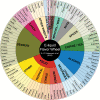An E-Liquid Flavor Wheel: A Shared Vocabulary Based on Systematically Reviewing E-Liquid Flavor Classifications in Literature
- PMID: 29788484
- PMCID: PMC6751518
- DOI: 10.1093/ntr/nty101
An E-Liquid Flavor Wheel: A Shared Vocabulary Based on Systematically Reviewing E-Liquid Flavor Classifications in Literature
Abstract
Introduction: E-liquids are available in a high variety of flavors. A systematic classification of e-liquid flavors is necessary to increase comparability of research results. In the food, alcohol, and fragrance industry, flavors are classified using flavor wheels. We systematically reviewed literature on flavors related to electronic cigarette use, to investigate how e-liquid flavors have been classified in research, and propose an e-liquid flavor wheel to classify e-liquids based on marketing descriptions.
Methods: The search was conducted in May 2017 using PubMed and Embase databases. Keywords included terms associated with electronic cigarette, flavors, liking, learning, and wanting in articles. Results were independently screened and reviewed. Flavor categories used in the articles reviewed were extracted.
Results: Searches yielded 386 unique articles of which 28 were included. Forty-three main flavor categories were reported in these articles (eg, tobacco, menthol, mint, fruit, bakery/dessert, alcohol, nuts, spice, candy, coffee/tea, beverages, chocolate, sweet flavors, vanilla, and unflavored). Flavor classifications of e-liquids in literature showed similarities and differences across studies. Our proposed e-liquid flavor wheel contains 13 main categories and 90 subcategories, which summarize flavor categories from literature to find a shared vocabulary. For classification of e-liquids using our flavor wheel, marketing descriptions should be used.
Conclusions: We have proposed a flavor wheel for classification of e-liquids. Further research is needed to test the flavor wheels' empirical value. Consistently classifying e-liquid flavors using our flavor wheel in research (eg, experimental, marketing, or qualitative studies) minimizes interpretation differences and increases comparability of results.
Implications: We reviewed e-liquid flavors and flavor categories used in research. A large variation in the naming of flavor categories was found and e-liquid flavors were not consistently classified. We developed an e-liquid flavor wheel and provided a guideline for systematic classification of e-liquids based on marketing descriptions. Our flavor wheel summarizes e-liquid flavors and categories used in literature in order to create a shared vocabulary. Applying our flavor wheel in research on e-liquids will improve data interpretation, increase comparability across studies, and support policy makers in developing rules for regulation of e-liquid flavors.
© The Author(s) 2018. Published by Oxford University Press on behalf of the Society for Research on Nicotine and Tobacco.
Figures


References
-
- Bertholon JF, Becquemin MH, Annesi-Maesano I, Dautzenberg B. Electronic cigarettes: a short review. Respiration. 2013;86(5):433–438. - PubMed
-
- Czoli CD, Goniewicz M, Islam T, Kotnowski K, Hammond D. Consumer preferences for electronic cigarettes: results from a discrete choice experiment. Tob Control. 2016;25(e1):e30–e36. - PubMed
Publication types
MeSH terms
Substances
LinkOut - more resources
Full Text Sources
Other Literature Sources

